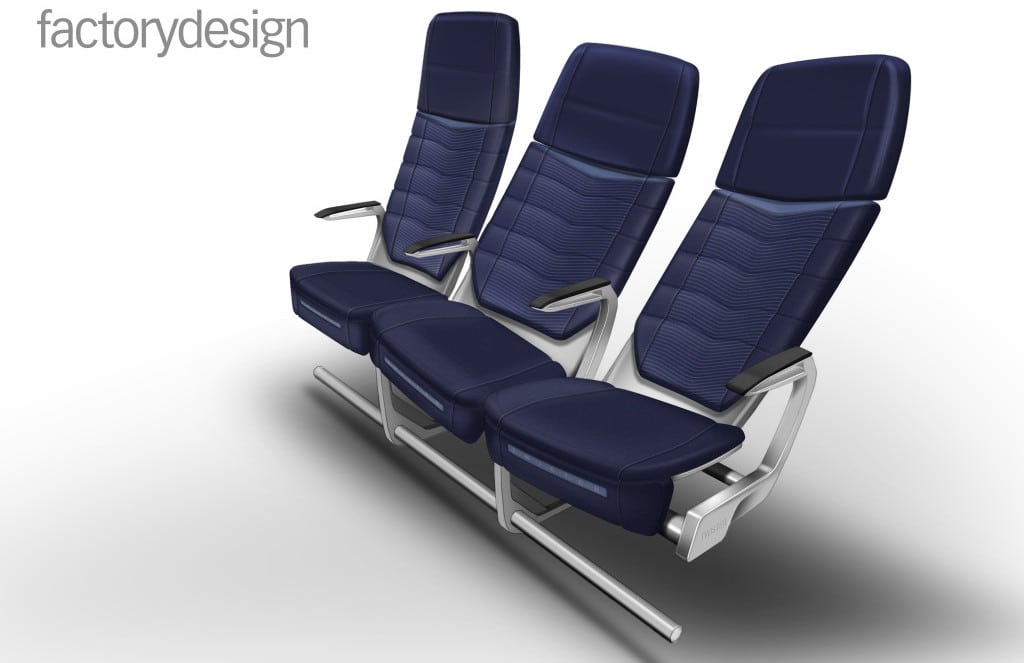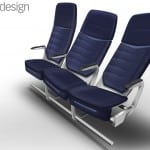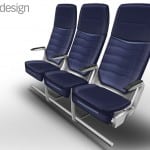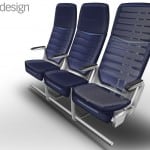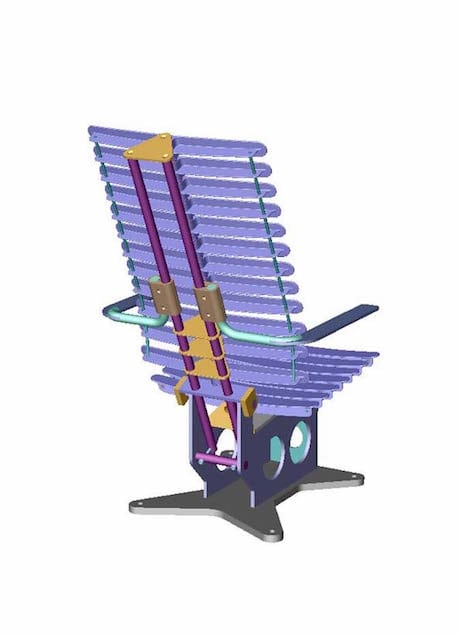Skift Take
There are many hurdles ahead before a concept as radical as the Twister could take-off, but it has sound principles in ergonomics to back it, and recognizes a pressing need for more healthful conditions in very long-haul Economy. If nothing else, White and Factorydesign have started a very important dialogue.
- Factorydesign Twister seat finished rendering, twisting.
- Factorydesign Twister seat, upright.
- Factorydesign Twister seat with view of frame underneath.
If you find long-haul flights in the Economy cabin excruciating, take some comfort: you’re not alone.
The industry’s designers fly long-haul Economy too, and they’re not immune to the pain.
One designer, however, has taken his inspiration from human anatomy to reduce the pressure which builds up in the body during very long-haul flights.
Adam White, Director of London-based Factorydesign, came up with the idea of the Twister seat at 35,000 feet, while trying (and failing) to find a comfortable position.
“I have had to fly many long-haul flights in Economy, but it was just one of those moments where, seven or eight hours in, I reached a point where I was no longer comfortable,” White tells us. “I realized that, while I was twisting and turning, the seat was only working as a hinge, and that’s not how the body is. That’s where the idea of a seat that twisted to the body came from.”
From Hinges to Spines
White began drafting up his concept of a Twister seat with articulating rib structures pivoting on a central spine both on the seat back and on the bottom, which allow the seat to shift its shape as the body does.
“The real breakthrough of the idea was that all previous seats were based on, essentially, a series of hinges,” says Adam White, director of Factorydesign. “The backrest would hinge back, the footrest would hinge up. But my observation was that I’ve got a spine, which means I twist and turn one way and another. By putting a spine into the seat, it allows the freedom of movement, twists and turns, without creating pressure points. If you cross your legs, you get very strong pressure point under your thigh at the edge of the seat. In a Twister seat, the seat twists down at that point, and relieves pressure.”
Break-Away Design
The Twister seat breaks away from long-established conventions of design in the sector.
“It is interesting that in Economy class, particularly, there’s been a push for how light you can make it, and that’s all that anyone ever talks about. It’s like the mobile phones, when all anyone ever talked about was making them smaller. Lightweight is important and that’s an entirely valuable contribution to what makes a modern aircraft.”
“But at the same time, at the front of the aircraft, we seem to be adding features, so what about Economy? Can we imagine something new? All we do is make it lighter, but the Twister seat is a new ball game. The focus is on providing a better experience for the passenger.”
And it’s not just a radical way to think about seating in the skies—it’s like nothing we’ve seen on the ground either.
“The patent agent who works for us did a quick search and couldn’t find anything similar,” White tells us. “We have an ergonomics consultant who works with us, he thought it was a good idea. We presented the core concept to government funded awards and won a fairly big prize for the innovation: the Smart Award. When we won the money, we used it to fund four full-sized working prototypes, and we used these to run a full ergonomic trial, then launched a proper patent search. Our patent search went through the UK, Europe, U.S. and nobody had ever registered anything like this..based on ribs adjusting to how your body works.”
From Prototype to Flight
White shared images with us of the seat spine for these prototype models, and renderings of how the seats might look once they’re all dressed up.
“The [original] images show essentially what we’ve made, a total of four prototypes made, with the flexible ribs bars that then would should have upholstered cushions over the top,” White says. “It wasn’t intended to be a visual design. What they were made for was to test the structure, and to test how significant a difference there would be between normal seats and the Twister seats. We found it works extremely well. You can build that into what appears to be quite a normal seat.”
Breaking ground on design in the aircraft seat industry is very tricky business, severely limited by the safety certification requirements of the structures which require, among many other things, destructive testing to 16Gs (at sixteen times the force of gravity).
White believes these issues, and issues of how the seat will actually work in service, are best addressed in the next phase of development: through a collaboration with a manufacturer.
“It needs to be engineered properly,” White says. “The original work we did was to have a full working prototype made. While we’re a creative and innovation driven business, we’re not really able to get involved in manufacturing. What we still need to do is talk to manufacturing partners.”
White has a vision of how the Twister seat will evolve, as shown in the renderings, and how it would function.
“What we want is that it twists with you as you twist into it, and then have it hold the shape. It will be more refined, with controls,” he says.
Today’s Unhealthy Long-Haul Experience
Perhaps the most important feature of the Twister design concept is that it acknowledges ongoing issue of health and well-being on very long-haul flights, which today’s Economy seats fail to address. The stiff structures build up pressure on the body which some believe can increase risks of Deep Vein Thrombosis. Some airlines have tried to address these risks by installing footrests and encouraging passengers to perform in-flight seated exercises, but it is still a concern that looms over very long-haul flights for those who frequently fly this way.
“There are great economy class seats, but you can only sit in them for so long. On very long-haul economy classes you’re really asking more than anybody should have to do,” White says. “At the same time, I understand that airlines have to ask people to stay seated, and it’s universally accepted. I might want to get up and walk around and do all the normal things every hour or two, but you of course, you can’t. So you have to ask what do you do to improve it? You have to allow the body to twist and turn.”
The Twister also aims to let passengers rest better onboard, by achieving a more reasonable sleeping position.
“We’ve all curled up for comfort, but you can’t do that in a hinged seat. With the Twister, that shapes twists and shapes to your body,” says White. “It’s more comfortable and therefore more healthy.”
The Daily Newsletter
Our daily coverage of the global travel industry. Written by editors and analysts from across Skift’s brands.
Have a confidential tip for Skift? Get in touch
Photo credit: Factorydesign Twister seat, rendering, twisting position. Factorydesign
